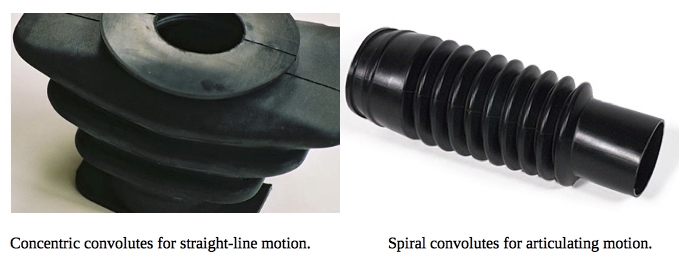Rubber Bellow Geometry:
The design of a custom molded rubber bellow follows five steps:
- Understanding the direction of travel required
- Understanding the length of travel required
- Understanding the interface between the two rubber bellow ends and the mating components
- Understanding the outside constraints or the envelope within which the rubber bellow has to function
- Understanding the environment in order to select the right material
1. Understanding the direction of travel required:
There are two types of convolutes used in molded rubber bellows; concentric and spiral. It's important to understand the advantages of both to ensure the right choice is made.

When the motion in question is straight up and down or out and back, concentric convolutes work best. They are simpler to machine in the mold and they tend to maintain their shape as they flex back and forth.
When the motion has any articulation to it at all, spiral convolutes are the best. Spiral convolutes do not kink or pop out of shape when bent in the middle - as concentric convolutes tend to do.
2. Understanding the length of travel required:
The length of the stroke required by the application can be accomodated in two basic ways and the choice is dependent on the constraints of the surrounding environment. First, the delta between the peak and valley of the convolutes can be large, with fewer numbers of convolutes - this requires more available space around the application. Second, the delta between the peak and valley of the convolutes can be smaller, with more convolutes - this is the direction to go if the surrounding area is constrained.
In short, the design has to insure that there is enough material between the peaks and valleys of the rubber convolutes so that when fully extended, the shape is still convoluted - if any rubber bellows is stretched beyond it's designed maximum, the rubber peaks tend to buckle inward and then when the bellows is compressed, the part doesn't collapse back properly.
3. Understanding the interface between the two rubber bellow ends and the mating components:
In order for rubber bellows to perform their role properly, they have to be secured at both ends of the aparatus in question. There are inumerable ways to accomplish this, some include:

An extended straight section with a retaining bead and a hose clamp

A locking grommet feature that secures the bellows into a panel or sheet metal

An integrated flange that extendes out beyond the convolutes with mounting holes

When the bellows is protecting something that simply goes up and down, there may not be a need to secure one end - it may be completely enclosed.
4. Understanding the outside constraints or the envelope within which the rubber bellow has to function:
In generaly, things keep getting smaller and more compact. Rubber bellows are flexible enough to be designed into just about any tight space.
- Tapered rubber bellows (or conical rubber bellows) are often used to accomodate mechanisms inside the bellows that are also tapered in shape.
- Straight rubber bellows (or cylindrical rubber bellows) are often used when external space constraints exist.
- Finally, the number of rubber convolutes dictates the difference between peak OD and valley OD - the tighter the outside space constraints, the more, smaller rubber convolutes can be added.
5. Understanding the environment in order to select the right material:
It's important to select the right rubber material for the applicaiton and the environment. Most rubber materials will have the flexibility to be used in rubber bellows applications - Custom Rubber Corp. can work with you to identify the best, most cost effective material for your application. Below is a table with some general information about the different rubber material options and their performance under various conditions.
Rubber Compounds for Rubber Bellows
| Material |
Abbreviation |
Flex Fatigue |
Relative Price |
Temperature Range |
Ozone, UV Resistance |
Oil Resistance |
| Ethylene-Propylene |
EPDM |
Excellent |
Excellent |
-70F to 250F |
Excellent |
Poor |
| Nitrile |
NBR |
Fair |
Good |
-30F to 250F |
Poor |
Excellent |
| Neoprene / Chloroprene |
CR |
Excellent |
Excellent |
-60F to 220F |
Good |
Fair |
| Silicone |
VMQ |
Excellent |
Fair |
-175F to 450F |
Excellent |
Fair |
None of the molded rubber parts pictured below are in stock or for sale. These are all examples of custom-manufactured products that illustrate Custom Rubber Corp.'s capabilities.